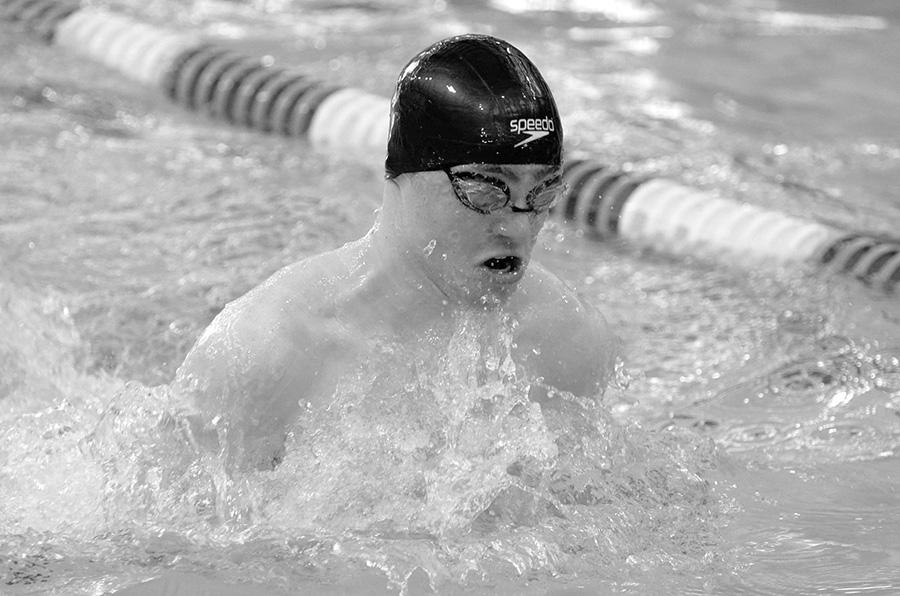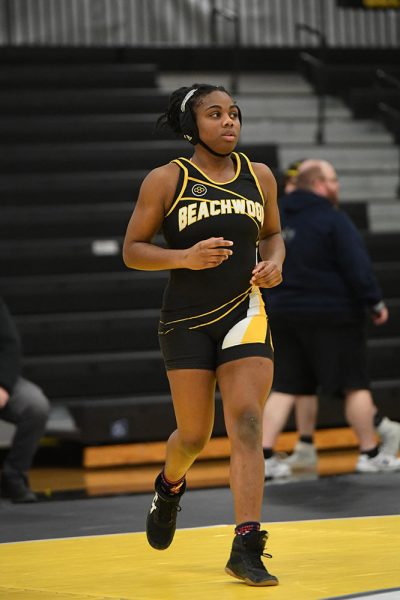What Does it Take to Get to the State Swim Meet?
Senior Wes Darvin is the first male BHS swimmer to compete at the state meet in at least 20 years.
If at all possible, I urge you, dear reader, to imagine this: You wake up before 6:00 a.m. You grab your laptop, books and swimming gear and get in your car. It’s cold outside. You drive to school and rush across the parking lot. Some of your fellow swimmers are already there, and a few more trickle in every two minutes or so. Once everybody is there, you and your teammates begin lifting. It’s cold in the weight room.
“We wake up at 6:15 each morning to go lift,” swim captain Wes Darvin told me a few months ago, when I was considering joining the team. I was intimidated.
On Feb. 20, Darvin competed in the state swim meet in 100-yard breaststroke. He was one of seven BHS swimmers to compete at this year’s division II district meet, but Darvin was the only one to advance after making a 1:02.45 time, becoming the first Beachwood male to qualify for states in at least twenty years.
It was the swim team’s grueling practice schedule that got him there.
Darvin began each morning of swim season with forty minutes in the weight room. At 7:00 he was already sweating, tired and grappling with the temptation to go back to sleep. He would rush to shower, change and squeeze in a small breakfast. The announcements always began way too early, urging him to hurry to first period. The rest of the day was spent rushing through cold hallways, fitting in times to eat and prepare his body for the afternoon practice.
Occasionally, he might get a weird stare or a question about why his hair was bleached. He might answer, as junior Monica Colmenares told me, that the bleached and shaved heads are a swimming tradition to build team spirit.
By 2:40 on a cold day of swim season, Darvin was exhausted, still recovering from the morning. His body called out for sleep and food. Nevertheless, he forced himself to check in with teachers, get some homework done or do something productive. On a day that was not too busy, he might have squeezed in a nap by the pool before practice. The deck and locker rooms were hot and humid.
“As you go throughout the season, practices get harder and harder,” sophomore Sophie Schoen told me.
Around 4:00, practice began. First came the dry land workout. For thirty minutes, Darvin and his teammates repeated planks, burpees and push-ups. After five minutes on the humid pool deck, he was swimming in his own sweat. All workouts were timed. Thirty seconds of non-stop burpees. Thirty more. Thirty more. His body wanted to give up, but the coach kept pushing. If he let himself give in, he’d get thirty more seconds. So he would keep going, fighting to repeat the exercise. It was oppressive on the pool deck.
Immediately after dry land practice, he would get in the pool. For the next hour and a half, his life was counted in laps. The warm-up, around nine laps, is never that horrible. It’s what comes after that’s difficult. More often than not he would sprint, straining himself to swim at top speed while maintaining the proper form. Following each lap, coach Burget would bark a correction for a swimmer to make in his or her stroke. Each swimmer would dive back in, ready to do it better.
Towards the end of the seven-thousand yard practice, he began to feel the exhaustion. He had to take more breaths for air. His stroke was slower. It got harder to maintain form. And yet his coach was still barking, calling each swimmer out by name… pushing all to make the last one count. It was freezing in the water.
But swimmers know that the coaches are there for them.
“They are always giving you suggestions to improve your stroke and speed,” said Colmenares.
“Our coaches push you as hard as you can go for as long as you can,” explained sophomore Bagatur Askaryan.
As each day of swim season came to a close, Darvin swam his final lap in practice. He struggled against his body to keep his form tight, his stroke clean. He wanted to gasp for air, but only allowed himself to come up for enough air to keep going. He wanted to quit, to give up, to take it easy, to stop caring. But he maintained the discipline to carry on and finish the practice. Ten minutes later he would be ready to leave. The ride home was a cold one.
The next day, he repeated the cycle.
When I asked her why she thought swimming was so hard, Colmenares said, “because of the mentality to keep pushing yourself even when you’re too tired to keep going.”
That is what a swimmer’s life is every day: Ignoring the cold, the heat, the pain, the hunger, exhaustion, the lack of oxygen, all to just keep going. Why is swimming so hard? Because of the discipline and mental strength that it takes to not give up. Because swim season isn’t just swim season. It’s a full-year commitment. Because it’s more than just pushing through water. It’s concentrating on perfecting every single aspect of the technique, because if one small thing is wrong, you’ll be infinitely slower. Why is swimming so hard? Because it’s not just a sport, it’s a lifestyle.
















